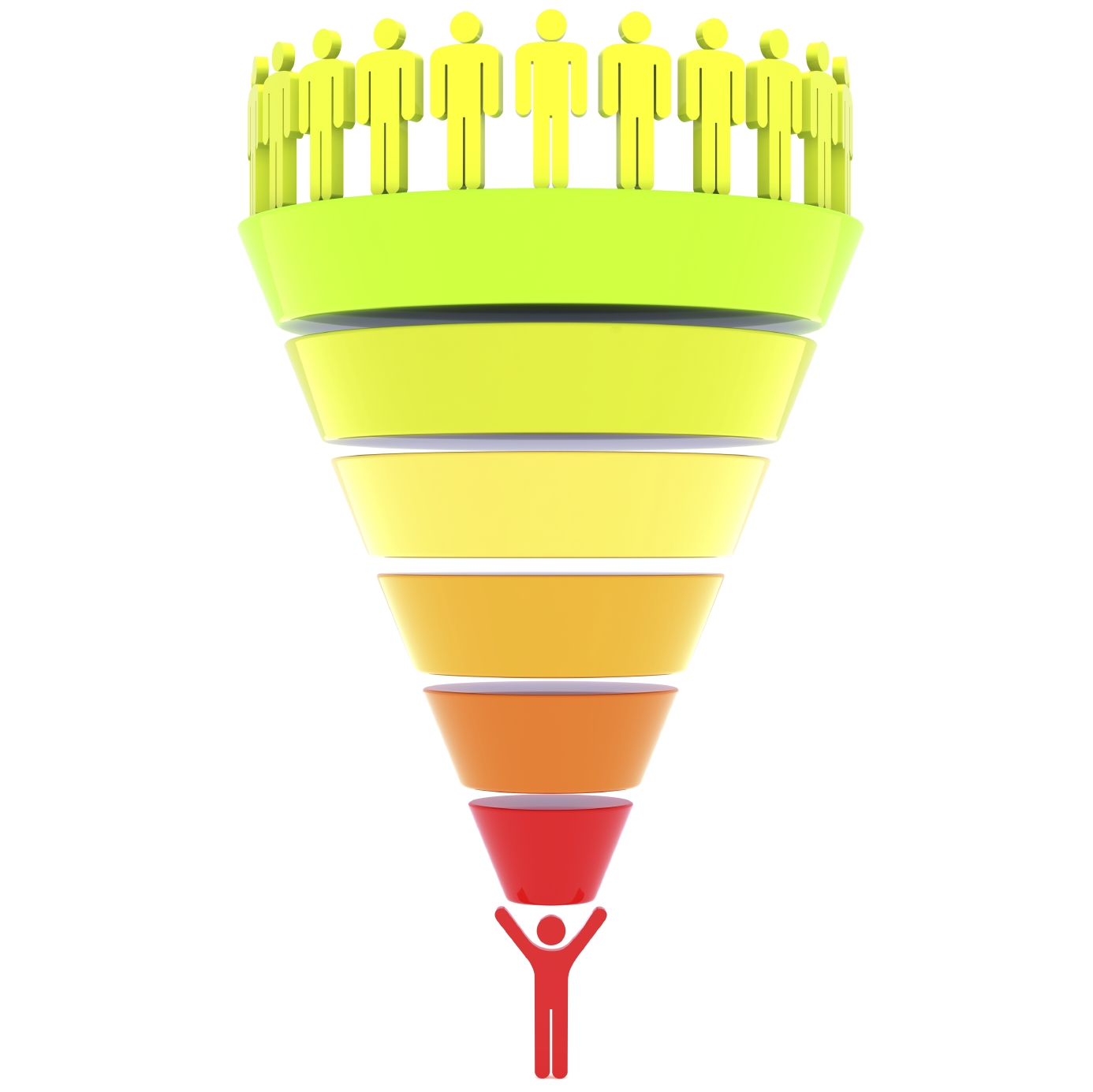By Laurie B. Beasley, Co-Founder and President, Beasley Direct Marketing, and Tom Judge, Vice President Strategy, Direct Marketing Partners

If you’ve followed our first two posts on this subject, you understand why it can easily take 13 or more “touches” to convert a prospect into a sales-ready qualified lead. But there are some ways to shorten the process. In this installment we’re going to examine four of those ways.
1. Plan with the Perfect Customer in Mind
We recommended in Part 2 that Sales and Marketing agree on the Perfect Prospect Profile. This includes the prospect’s position, role in the buying process, how they go about solving their problems, authority/influence on purchasing decisions, urgency and the level of need for your solution. Because today’s large purchases are often a team effort, be sure to profile every member of a typical purchasing team, which may include four to five members.
This involves a review of the historical sales data. Segment it by customer types and review the profitability data for each. Be sure that you have a thorough understanding of the buying process, and that all relevant “buyer-personas” are included. Determine what percent of prospects are converted from basic leads into “sales-ready” qualified leads. Of these, determine what percent then convert from qualified leads to paying customers. (Sales may already have this data on hand.) These are both important KPIs to identify.
Once you have built personas for each member of the buying team, develop relevant messaging for each of them. If at all possible, it would be helpful to interview some customers in each position about their concerns and role in the purchasing process to gain more insight.
2. Clearly Define a “Sales-Ready Qualified Lead”
Sales-ready criteria are defined by Sales, not Marketing, so you need to turn to your good friends in Sales to get this information. Develop your qualification criteria to include data points required by the Sales team to stage a sales campaign with a high probability of closing that perfect customer.
As we outlined in our Lead Generation Guide, digital profile data alone is too limited, as is web traffic scored leads. And we have already discussed that prospects are reluctant to provide detailed information on a landing page until they feel sufficiently comfortable about the B2B relationship. So it’s time to unplug and get into a peer-to-peer dialog with prospects via those old-fashioned devices, the telephone and the human touch. Remember, this is a pre-sales discussion; it’s not yet in the hands of the sales person.
By taking a personalized approach to the conversation, you can begin to build a pre-sales relationship that may inspire a prospect’s confidence to the point where s/he may now be willing to share information such as:
- What are the challenges or business issues they are facing?
- What is their sense of urgency to resolve?
- What are they doing today?
- What alternatives are they looking at?
- Job title and role in the buying process?
- Current stage in the buying/research process?
- Time frame to purchase?
- Size of opportunity?
- Existing budget (or do we need to build a business case?)
- Is the prospect willing to talk to your sales rep? (Getting in early provides an opportunity to influence specs! Wait too long and your company is an outsider with slim chances of winning.)
- If they don’t meet the sales-ready condition yet, then move them into a 1:1 nurture track until ready and don’t waste the sales team time resources.
3. Quantify your “Sales-Ready” Lead Quota
Ultimately, it all comes down to numbers. Well-thought-through numbers are what you need to convince Management that Marketing requires additional resources to implement a pre-qualification program to impact sales.
Figure 1 illustrates a simple lead requirements calculator. Starting with your organization’s annual sales revenue goal, break it down into revenue per quarter and average revenue per sale. That will tell you how many sales per quarter must be closed to meet sales goals. You can also create lead generation requirements models by territories, division or numbers of product deals, etc.
Figure 1: Sample Lead Requirements Calculator

Source: Direct Marketing Partners
From the historical sales data that you have analyzed, you can fill in the percentage of prospects converted to qualified sales-ready leads, and the percentage of those qualified leads that convert to sales. This will tell you how many sales-ready qualified leads Marketing must produce per quarter and per month to meet sales objectives. It’s our observation that most firms miss this important step in their plans!
Now you can calculate the resources Marketing will need to take on the added task of pre-qualifying leads for Sales. And you can calculate the ROI of adding these resources, whether contracted from a vendor, or by hiring. This is the kind of hard data Management will need and demand to allocate additional resources to Marketing.
Don’t be afraid to play with the numbers. Run them bottom-up and top-down. Create different models for different buying scenarios. Look at the sales steps and current conversion rates. Then create your comprehensive multi-touch demand generation, nurturing and lead qualification plan to feed your company’s sales funnel with confidence.
4. Align Sales, Marketing and Management with Your Lead-to-Sale Plan
Starting with the Perfect Prospect Profile, make sure that your Sales partners and Management are completely on board with your program—in writing. It’s especially important that Sales or channel reps have signed off on a commitment to engage sales-ready prospects within a certain period of time, and that this is all tracked in the CRM system. Your best efforts will go for naught if Management doesn’t allocate the proper resources, or if Sales lets your hot, sales-ready qualified leads slip out of the sales funnel.
In our next installment, we’ll discuss more ways to shorten the seven to 13 touches to make this process even more efficient.
* * * *
This blog was authored by Laurie B. Beasley, co-founder and president of Beasley Direct Marketing, Inc., and Tom Judge, vice president Strategy at Direct Marketing Partners.
 Beasley Direct is a Silicon Valley direct marketing agency that has managed search, email, online, and demand generation campaigns for nearly 100 companies. Ms. Beasley serves as President of the Direct Marketing Association of Northern California. She manages the eMarketing Roundtable for the BMA Northern California. She is also an instructor of online marketing at UC Berkeley Extension and teaches for the Online Marketing Institute. Ms. Beasley frequently speaks on online marketing and demand generation topics for marketing organizations, including the DMA, BMA, AMA, Tech Council, and the Online Marketing Summit.
Beasley Direct is a Silicon Valley direct marketing agency that has managed search, email, online, and demand generation campaigns for nearly 100 companies. Ms. Beasley serves as President of the Direct Marketing Association of Northern California. She manages the eMarketing Roundtable for the BMA Northern California. She is also an instructor of online marketing at UC Berkeley Extension and teaches for the Online Marketing Institute. Ms. Beasley frequently speaks on online marketing and demand generation topics for marketing organizations, including the DMA, BMA, AMA, Tech Council, and the Online Marketing Summit.

Tom Judge
Direct Marketing Partners (DMP) is a lead management and lead funnel tele-qualification services provider for B2B selling firms. Services include multi-touch peer to peer tele-prospecting and email lead gen campaigns with marketing automation and funnel metrics to optimize lead-to-sale conversions. Tom Judge provides strategic guidance for DMP clients and educational workshops on optimizing B2B lead-to-sales funnels for companies and at industry conferences. He also serves as the Vice President DMA Northern California Chapter, Contributor at Sales Lead Management Association www.salesleadmgmtassn.com, Program Chair for the NorCal BMA Sales Lead Roundtable www.norcalbma.org, former Instructor on Sales Lead Management, San Jose State University and UC Professional Development Programs.

